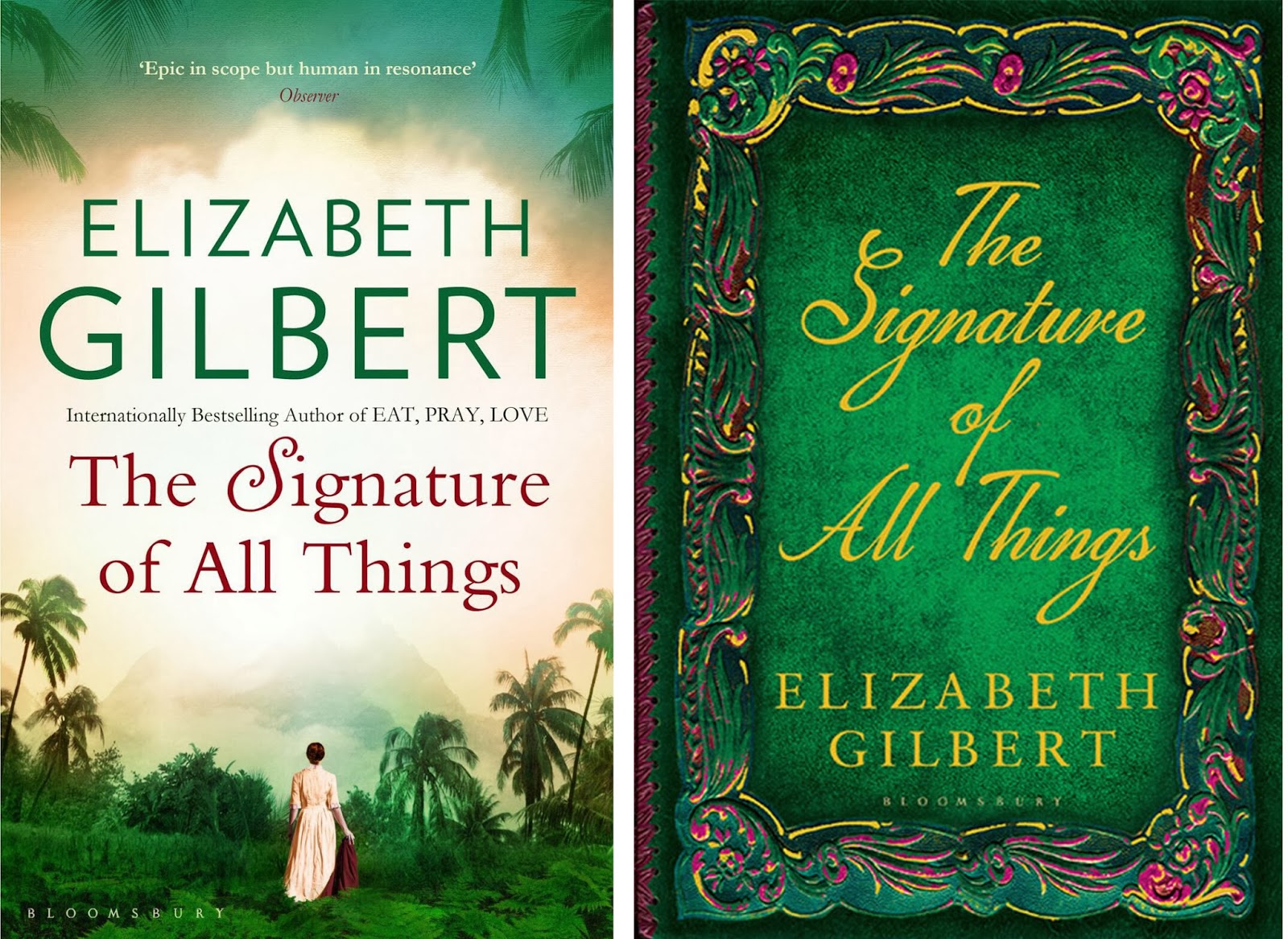The American and English covers for The Signature of All Things
by Elizabeth Gilbert
There is an ancient concept that God created some plants, or their parts, to resemble certain areas of the human anatomy, and that these plants may therefore be used to cure specific human ills. Such a theological justification of faith in a caring, universal god was the concept of one Jakob Bohme (1575-1624) whose own 'The Signature of All Things' was the book that contained the 'proof' of his doctrine. And now that central thesis, along with Bohme's book's title, have inspired another remarkable book.
The Signature of All Things is a novel by Elizabeth Gilbert that tells the story of Alma Whittaker ‐ the daughter of Henry, the man to whom we are first introduced when he is a boy whose own father works as a horticulturalist at Kew. Henry leaves his home to travel overseas with Captain Cook and, indeed, so fascinating is the depiction of Henry's early life that it is something of a wrench to leave the centre of his world at the time of his daughter's birth.
Alma is ‘born with the century’ in the year of 1800. She is raised in privilege and wealth on her father’s vast Philadelphia estate - his success built on sheer determined grit, and on his business acumen to use plants as pharmaceuticals.
Physically, Alma is plain and large ‐ a harsh fact of which she is ignorant until her parents go on to adopt the beautiful child, Prudence. Intellectually, Alma is a prodigy who yearns for scientific truth, to understand the wider world and what her place in it might be. In the smaller world of emotions she flounders. While longing for friendship and love she very often misunderstands the affections of those around her. As a youth on the verge of adulthood, Alma’s growing sexual needs are enhanced by the pornographic books she finds in her father’s library. These she reads in the cramped hot darkness of the library’s tiny binding room - the claustrophobic haven which is also a poignant symbol for the secrets kept in Alma’s mind. This venue, much later on, will form the dramatic backdrop for the intensely moving scene of Alma's first sexual communion with another human soul ‐ though not in any conventional way.
Some Victorian botanical illustrations of moss
Alma is a remarkable character. She is the beating heart of this sprawling and intricate novel ‐ the star in its central orbit who every reader will come to love: not just for the sake of her goodness, but because of her vulnerability when all around presume her to be as steady and needless as a rock. It is a fine poetic touch that Alma’s main subject of botanic study are the mosses that grow upon such rocks ‐ those down-trodden humble organisms through which her own deductions are made regarding the evolution of life.
Some botanical illustrations of orchids - in all of their flamboyant 'sexuality'
By contrast the man Alma comes to love, the ethereal young Ambrose Pike, studies exotic orchids of which he makes glorious paintings. And despite enormous differences in many aspects of their lives, there is a spell when the two of them form a bond which leads to great happiness.
Happiness. Contentment. Fulfilment. The need to love and to be loved, both physically and spiritually, are the things that Alma longs for most: the things she needs to understand. In middle age this yearning will lead her to leave her American home and travel around the globe. The time that she spends in Tahiti - following in the footsteps of her father, and also Ambrose Pike - is alluringly described, and the island provides a wonderful scene in a cave of fool’s gold which is lush with moss - where Elizabeth Gilbert stresses the fact that even the very humblest moss may be as intrinsically glamorous as the most exotic of blooms.
The final chapters are fascinating for their insight into scientific thought in the mid-nineteenth century, and how the work of Charles Darwin and Alfred Russel Wallace was to turn the world upon its head in relation to long-held concepts of creation - of Science versus God.
Alfred Russel Wallace
Alma’s fictional meeting with the factually real Alfred Russel Wallace leads to the expression of notions held dear to both their hearts - in that there is some greater force than what we can know in this earthly realm: some spiritual universal truth that leads to man's altruistic thought ‐ that spiritual part of the human mind which cannot be explained away by physical evolution alone.
The ideas are fascinating, yet conveyed with such a readable charm that belies the complex philosophy that Elizabeth Gilbert has 'evolved' to create this big and beautiful novel ‐ as big and beautiful as is the nature of Alma Whittaker.
The VV will now end this post with the words of Elizabeth Gilbert herself, when she talks about what inspired her to write The Signature of All Things -
For another Virtual Victorian post based on a remarkable woman who existed in the Victorian age, and who travelled to Africa in pursuit of her own scientific dreams, please see this short article about Mary Kingsley: POETIC OBSERVATION ON AFRICA
For more on Alfred Russell Wallace, the Victorian natural scientist who many feel was overlooked when Darwin rose to prominence, please see this article by the Historical Crime novelist, D E Meredith: ALFRED RUSSEL WALLACE ~ THE BUTTERFLY MAN.


